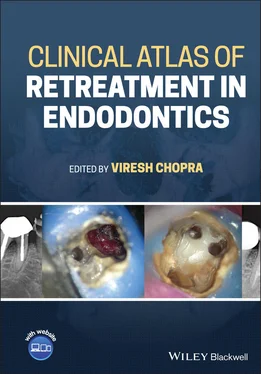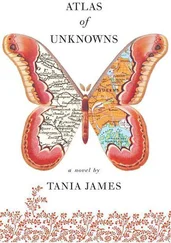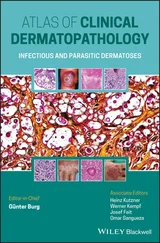2 Chapter 2 Figure 2.1 Preoperative intraoral periapical radiograph with separated instr... Figure 2.2 Intraoral periapical radiograph showing instrument bypass. Figure 2.3 Intraoral periapical radiograph showing periapically extruded sep... Figure 2.4 Intraoral periapical radiograph showing obturation. Figure 2.5 Incision and flap reflection. Figure 2.6 Trephination at the site. Figure 2.7 Intraoral periapical radiograph showing the location of the extru... Figure 2.8 Curettage of the operating site. Figure 2.9 Retrieved instrument. Figure 2.10 Intraoral periapical radiograph showing instrument retrieval. Figure 2.11 Immediate postoperative intraoral periapical radiograph. Figure 2.12 Flap approximation and suturing of the operated site.Figure 2.13 Postoperative intraoral periapical radiograph after 1 month.Figure 2.14 Postoperative intraoral periapical radiograph after 1 year.
3 Chapter 3Figure 3.1 Preoperative clinical picture.Figure 3.2 Preoperative radiograph showing inadequate obturation and fractur...Figure 3.3 Gutta‐percha cones removed from the root canals.Figure 3.4 Bypassing the fractured instrument with a no. 10 manual K‐file an...Figure 3.5 Verifying the fit of master cones up to the full working length o...Figure 3.6 Final obturation radiograph with bypassing of the ledge as well a...Figure 3.7 One‐year follow‐up radiograph with postendodontic full coverage r...
4 Chapter 4Figure 4.1 Intraoral periapical x‐ray: #34 – inadequately endodontically tre...Figure 4.2 Coronal access through the metal ceramic crown showing a single c...Figure 4.3 Unfilled lateral spaces around the single cone gutta‐percha.Figure 4.4 Gutta‐percha removed to the middle third of the root.Figure 4.5 Gutta‐percha removed to the the apical third of the root.Figure 4.6 After complete removal of gutta‐percha, visualization of the sepa...Figure 4.7 Intraoperative radiograph showing removal of the gutta‐percha and...Figure 4.8 Retrieval of the separated fragment after creating a staging plat...Figure 4.9 Magnified view of the retrieved segment of the rotary file.Figure 4.10 Intraoperative x‐ray confirming complete retrieval of the separa...Figure 4.11 Working length x‐ray confirming the length gained with Tooth 34....Figure 4.12 A second working length radiograph demonstrating the complexity ...Figure 4.13 Postoperative radiograph demonstrating root canal filling materi...Figure 4.14 Follow‐up radiograph at 13 months showing periapical healing.
5 Chapter 5Figure 5.1 Preoperative radiograph showing furcal perforation, inadequate ob...Figure 5.2 Clinical picture showing removal of the crown, removal of the cot...Figure 5.3 Radiograph showing location of the canals, working length determi...Figure 5.4 Radiograph showing repair of the perforation and obturation of th...Figure 5.5 Four‐month follow‐up radiograph showing healing in the furcation ...Figure 5.6 Clinical picture showing full‐coverage permanent restoration and ...
6 Chapter 6Figure 6.1 Preoperative radiograph showing suspected strip perforation, inad...Figure 6.2 Clinical picture showing the perforation site after removal of th...Figure 6.3 Clinical picture showing location of the fractured instrument und...Figure 6.4 A loop retractor is used to catch and extract the instrument afte...Figure 6.5 Removal of the fractured instrument.Figure 6.6 Preparation of GP as an apical plug to obturate the part of the r...Figure 6.7 Obturation of the apical part of the canal with GP. This segment ...Figure 6.8 Closure of the strip perforation site with MTA. Obturation of the...Figure 6.9 Immediate postoperative radiograph showing removal of the fractur...Figure 6.10 Two‐year follow‐up radiograph showing complete healing of the pe...
7 Chapter 7Figure 7.1 Periapical radiograph showing the previously treated tooth with o...Figure 7.2 (a,b) CBCT examination revealed an apical radiolucency as well as...Figure 7.3 Specially designed microexcavator instruments used for removal of...Figure 7.4 (a,b) Use of precurved file to evaluate the lateral anatomy of th...Figure 7.5 (a,b) Attempt to negotiate the lateral anatomy of the root canal....Figure 7.6 (a,b) Obturation of the root canal. Sealer can be seen flowing th...Figure 7.7 (a–e) CBCT images for 3‐year follow‐up confirming the flow of sea...
8 Chapter 8Figure 8.1 (a–d) Radiographs showing faulty cast post with a gap between the...Figure 8.2 A lateral opening drilled in the coronal one‐third of the crown....Figure 8.3 Exposed cast post after lifting of the crown.Figure 8.4 (a,b) Demonstrating the use of WAM X forceps for decementing the ...Figure 8.5 Disinfection procedure being carried out and the removal of gutta...Figure 8.6 Sectional obturation of the apical part is complete and the prepa...Figure 8.7 Radiograph confirming the sectional obturation along with post sp...Figure 8.8 Recall radiograph confirming healing of the lateral lesion follow...
9 Chapter 9Figure 9.1 (a,b) Clinical pictures showing tracking of the sinus tract with ...Figure 9.2 Preoperative radiograph revealing previously treated mandibular c...Figure 9.3 Periapical radiograph revealing obturation of the anterior teeth....Figure 9.4 (a,b) Clinical pictures showing healing of the buccal sinus tract...Figure 9.5 Periapical radiograph showing healing of the interdental radioluc...
10 Chapter 10Figure 10.1 Preoperative radiograph showing silver cone obturation and fract...Figure 10.2 Periapical radiograph showing removal of silver cone and cement ...Figure 10.3 Precurving the endodontic file with an endo‐bender.Figure 10.4 ET 25 ultrasonic tips used to loosen and remove the fractured in...Figure 10.5 Periapical radiograph showing obturation and post space preparat...Figure 10.6 Periapical radiograph showing healing of the periapical lesion 2...Figure 10.7 CBCT showing healing of the periapical lesion 2 years after the ...
11 Chapter 11Figure 11.1 (a) Clinical picture showing Tooth 16. (b) Periapical radiograph...Figure 11.2 CBCT imaging reveals presence of periapical radiolucency along t...Figure 11.3 (a) CBCT used for measurements on the occlusal surface. (b) Meas...Figure 11.4 Based on CBCT measurements on the occlusal surface, the estimate...Figure 11.5 Drilling depth marked with a stopper on the bur. Rubber dam remo...Figure 11.6 Guided access prepared without rubber dam. Previously obturated ...Figure 11.7 Missed MB2 discovered. 10 K file used to check canal patency. Le...Figure 11.8 (a) MB1 and MB2 shaped and cleaned with rotary endodontic files ...Figure 11.9 (a) Verification of master GP on the radiograph. (b) Immediate p...Figure 11.10 Follow‐up after 1 year showing complete healing of the periradi...
12 Chapter 12Figure 12.1 Various endodontic mishaps that can occur with freehand access p...Figure 12.2 How calcification can create a challenge during endodontic treat...Figure 12.3 Different ways of improving the accuracy of endodontic access pr...Figure 12.4 The steps of working with a 3D printed tooth replica.Figure 12.5 Comparison of the accuracy of guided implant placement with guid...Figure 12.6 Common lack of interocclusal distance to accommodate the additio...Figure 12.7 Demonstrating orifice directed access preparation.Figure 12.8 Demonstrating the marked pericervical dentine that can be preser...Figure 12.9 Different types of long shank small‐headed burs recommended to b...Figure 12.10 Periapical radiograph showing inadequate obturation in Tooth 11...Figure 12.11 DICOM files from CBCT and STL files from scanning were extracte...Figure 12.12 Searching and marking of identical points.Figure 12.13 After segmentation and alignment of the information (DICOM and ...Figure 12.14 Placement of virtual burs and sleeve for final template designi...Figure 12.15 Placement of virtual bur a bit palatally since orifice projecti...Figure 12.16 The placement and stabilization of the guide in vivo .Figure 12.17 Marking of the access entry point with a narrow bur on the rest...Figure 12.18 Once the marking was done, the hole was drilled freehand.Figure 12.19 After replacing the guide, the stability of the guide bur was c...Figure 12.20 After replacing the guide, the stability of the guide bur was c...Figure 12.21 Access created with the guide bur, used with the sleeve. Root c...Figure 12.22 Estimation of working length with an electronic apex locator.Figure 12.23 Negative pressure irrigation performed throughout the procedure...Figure 12.24 Obturation done with tricalcium silicate sealer and gutta‐perch...Figure 12.25 Reinforcement with glass fiber post.Figure 12.26 Core build‐up with resin composite.Figure 12.27 (a–f) Periapical radiographs showing verification of the steps ...
Читать дальше












